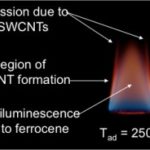Energy storage is among the 21st century’s principal challenges. Developing state-of-the-art, low-cost materials for electricity storage would pave the way for widespread adoption of electric vehicles and renewable energy. Lithium-ion batteries are attractive for portable devices, electric and hybrid electric vehicles as well as for large renewable power facilities. Layer-structured…
Read more
Single-walled carbon nanotubes (SWNTs) possess many unique electrical and mechanical properties. They can be conducting, semiconducting or insulating, based on their chirality. They also have a high surface area and a high strength-to-weight ratio. These properties make SWNTs desirable for many applications, including nano-electronic devices and composite materials. However, applications such…
Read more
Gas-phase combustion synthesis (GCS) has become the industry standard for the production of high-volume powders like silicon dioxide, titanium dioxide and carbon black, but until recently could not produce nonagglomerated, non-oxide materials. Despite past limitations, LACER has demonstrated and commercialized a GCS process to produce ultrafine, nonagglomerated, non-oxide ceramic, metal…
Read more




